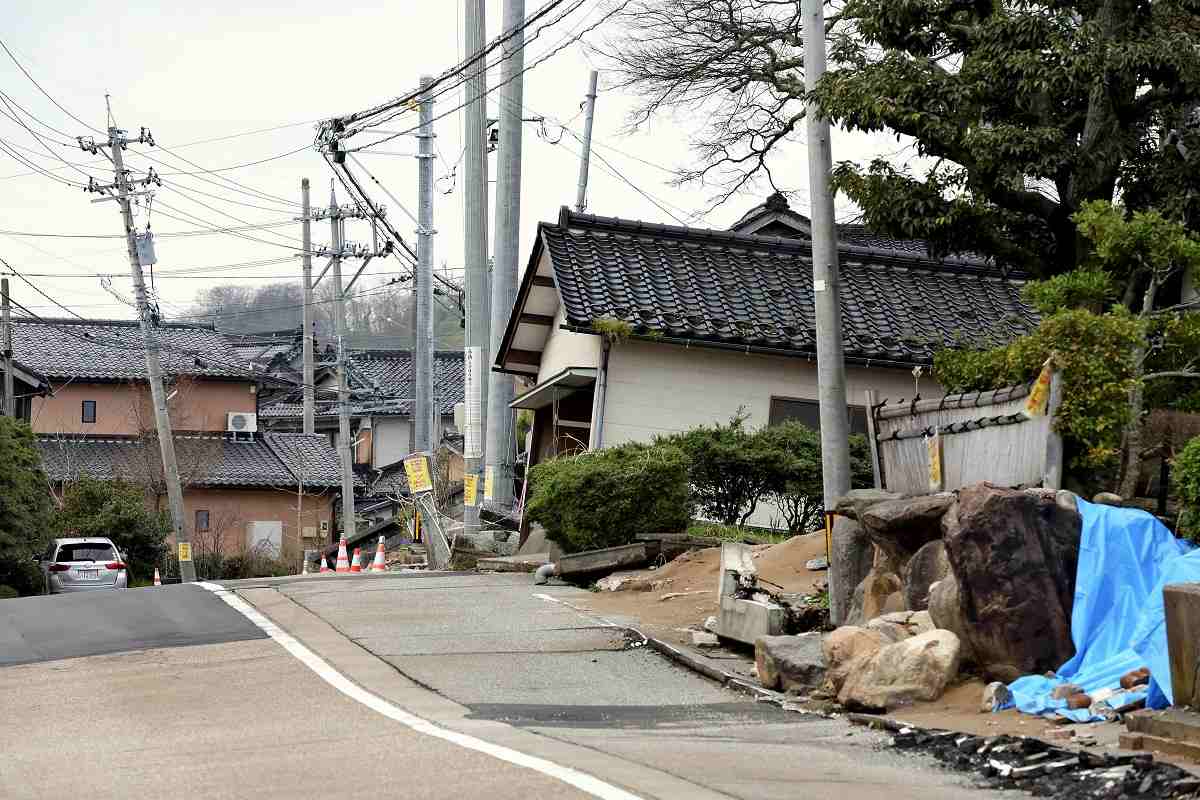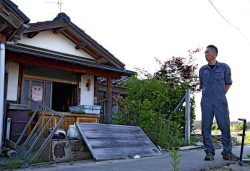Liquefaction Hinders Reconstruction from Noto Quake; Japan’s Central Government Plans to Boost Support

Liquefaction caused roads to swell, leaving buildings and utility poles tilted in the Osaki area of Kahoku, Ishikawa Prefecture on April 4.
6:00 JST, April 11, 2024
KANAZAWA — Damage from liquefaction is causing serious problems for the recovery efforts in four prefectures struck by the Jan. 1 earthquake on the Noto Peninsula.
Liquefaction occurs when particles of sand and other materials that make up the ground are loosened due to strong shaking, mingle with water within the ground, and liquefy. Buildings that sank together with their foundations will require a great deal of work, including reinforcement of the ground, and boundaries will need to be redetermined for land where the ground shifted significantly.
Local authorities have been unable to keep up with the demand, and the central government plans to step up its assistance for affected people in cooperation with local governments struck by the earthquake.
A residential street swelled in the Osaki area of Kahoku, Ishikawa Prefecture, and utility poles and houses were tilted. About 760 households live in the area, and a total of 308 disaster certificates had been issued as of April 1. Of those, 155 were recognized as “partially destroyed.” Most of the damage was caused by liquefaction.
The earthquake shifted the two-story wooden house of Katsunori Nakamura, a 62-year-old self-employed man, by about 1.5 meters, and caused the entire building to sink with its foundation, resulting in what was deemed “large-scale partial damage.” Elevation of the ground caused the garden, fence and stone steps to the entrance to collapse.
Nakamura decided not to evacuate because damage to the house itself was minimal. He lives there with his family after repairing water pipes, but cannot make up his mind to rebuild the house. It will take time and money to determine the borders of the shifted land and repair the foundation, but exactly how much remains unknown.
“It will require a tremendous amount of money to repair or rebuild the house. I need information about what kinds of construction methods are available and how much assistance I can get from the authorities,” Nakamura said.

Katsunori Nakamura, a resident of Kahoku, Ishikawa Prefecture, examines a damaged street in front of his house on April 4.
According to the Land, Infrastructure, Transport and Tourism Ministry, 15,000 houses in three prefectures had been damaged by liquefaction resulting from the Noto Peninsula Earthquake as of the end of February — 3,500 in Ishikawa Prefecture, 2,000 in Toyama Prefecture and 9,500 in Niigata Prefecture. There are also some cases in Fukui Prefecture. The full scale of the damage in northern Noto Peninsula, including the cities of Wajima and Suzu, remains unknown, so the scale of liquefaction damage is expected to further expand.
The Kahoku city government is considering establishing its own aid program, but it has yet to draw up specific measures. It plans to hold explanatory sessions for residents and take surveys to seek their opinions. However, there are some challenges to be addressed, a city official said.
“The quake changed land boundaries and the height of residential lands, so it’s difficult to decide what criteria to use,” said the head of the city government’s urban construction section. “We don’t have enough personnel or expertise.”
The land and infrastructure ministry is checking the damage and examining geological features of the sites where liquefaction took place, in cooperation with local governments. It plans to give advice on necessary measures, such as comprehensive ground reinforcement in residential areas around public facilities.
“It will take time to reinforce the ground by doing the necessary construction in large blocks of land, and residents’ agreement is also necessary to start work,” said a senior official of the land and infrastructure ministry. “We’ll determine what measures will be effective in keeping with individual situations and extend support for reconstruction while exchanging information with local governments.”
"Society" POPULAR ARTICLE
-

M4.9 Earthquake Hits Tokyo, Neighboring Prefectures
-

M7.5 Earthquake Hits Northern Japan; Tsunami Waves Observed in Hokkaido, Aomori and Iwate Prefectures
-

Israeli Tourists Refused Accommodation at Hotel in Japan’s Nagano Pref., Prompting Protest by Israeli Embassy and Probe by Prefecture
-

Tsukiji Market Urges Tourists to Avoid Visiting in Year-End
-

M5.7 Earthquake Hits Japan’s Kumamoto Pref., Measuring Upper 5 Intensity, No Tsunami Expected
JN ACCESS RANKING
-

Keidanren Chairman Yoshinobu Tsutsui Visits Kashiwazaki-Kariwa Nuclear Power Plant; Inspects New Emergency Safety System
-

Imports of Rare Earths from China Facing Delays, May Be Caused by Deterioration of Japan-China Relations
-

University of Tokyo Professor Discusses Japanese Economic Security in Interview Ahead of Forum
-

Japan Pulls out of Vietnam Nuclear Project, Complicating Hanoi’s Power Plans
-

Govt Aims to Expand NISA Program Lineup, Abolish Age Restriction




















